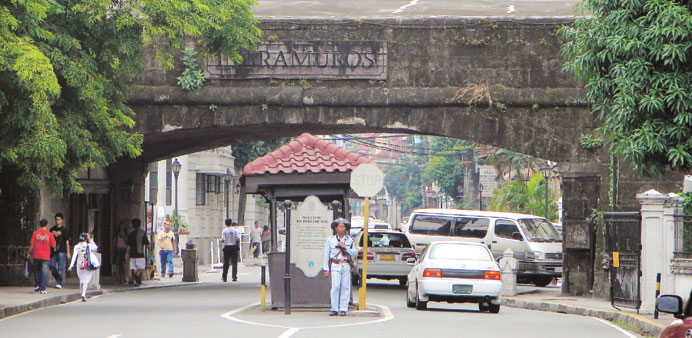Manila Times/Makati
The Intramuros Administration (IA) has embarked on a multi-year programme to improve the historic heart of Manila with nearly P2bn worth of restoration work to be implemented this year, a top official said.
IA Administrator Marco Antonio Sardillo 3rd said the scope of the work include refurbishing the streets and historic structures, widening of sidewalks, burying electricity wires underground and creating parking areas.
“This agency has been slumbering since 2009,” Sardillo said in an interview. “Intramuros is really a mini-city, and we [the IA] have many of the same powers as the city government, even a little more in some respects.”
The Intramuros District is mostly contained within centuries old walls, but it extends beyond the fortifications in some areas. The area, which include Fort Santiago where national hero Jose Rizal was imprisoned by Spanish colonial rulers, has an important role in Philippine history.
The IA is an attached agency of the department of tourism but it has full authority over planning, local zoning, business registration, and traffic management.
Sardillo said IA also has the power to declare eminent domain over property within its jurisdiction and “we are using those powers now.”
The IA has a technical assistance grant from the World Bank, which recommended restoration work together with efforts to make Intramuros greener and pedestrian-friendly.
Sardillo said he was optimistic some P970mn projects could be completed this year, including P120mn for the rehabilitation of Andres Soriano Avenue (Calle Aduana), which will entail reducing the street’s width to two lanes, widening the sidewalks, and relocating utility wires underground.
From his fifth-floor office in the Palacio del Gobernador, Sardillo pointed to the traffic flow on A. Soriano, which was heavy, but moving at a steady pace. “This is the natural traffic flow for Intramuros,” he said.
He said the traffic rerouting scheme, which was implemented this month, will be made permanent after the planned rehabilitation works which include the P320mn reconstruction and repair of other streets, particularly General Luna St., Intramuros’ main north-south thoroughfare; P200mn for a “bundle” of projects in Fort Santiago, including “de-cluttering” the central area “It has a very doña feel to it,” Sardillo said, adding that the current layout was conceived by Imelda Marcos.
The improvements, Sardillo said, will include refurbishing the barracks, updating the landscaping and outdoor lighting, and rehabilitating a number of presently off-limits areas so that they can be opened to the public. Also, P30mn was allotted for the construction of a new indoor events venue along General Luna St. and P300mn for the completion of a new Intramuros museum, which will be used in part to display some of the agency’s vast collection of artefacts, which comprises some 8,000 items worth an estimated P1bn.
Sardillo said a budget of up to P1bn have been set aside for the acquisition and restoration of the Aduana (also called the Intendencia), the colonial-era Customs House at Plaza Mexico, which has been one of Intramuros’ landmark ruins since it was gutted by fire and abandoned in 1979.
He said long-term plans include development of more off-street parking, creation of “shared spaces” such as mini-parks, and low-cost housing for Intramuros’ informal settlers.
The unique situation of Intramuros’ poorest residents is symptomatic of an oddly depressed environment, Sardillo said.
They are not “squatters”, as most of them actually live in legitimate though poorly constructed homes, and they work as street vendors and drivers, and on average earn well above minimum wage.
“There are many vendors who routinely net P1,000 a day,” Sardillo said. “If you ask the informal settlers, they’ll always describe themselves as ‘renters’, which is what they are.”
Sardillo said bad land use and low investment has led to depressed property values in the area.
“Land values here are roughly P40,000 to P50,000 per square meter,” he said, comparing them to the P120,000 to P150,000 per square meter price tag of property across the river in the area along Escolta.
“We would like to build that up. We’re considering, for example, relaxing the height restrictions in certain cases (buildings in Intramuros now, with a few exceptions, are limited to a height of about six floors), and the IA is willing to work with locators to bring new investments into the area,” he added.
Sardillo, whose term will expire with the end of the Aquino administration in June next year, expressed some anxiety about completing the agency’s ambitious plan, but he said he was optimistic that the work scheduled for 2015 can be finished on time.
“This will be a long-term initiative, however,” he said.

Entrance on Gen. Luna Street


